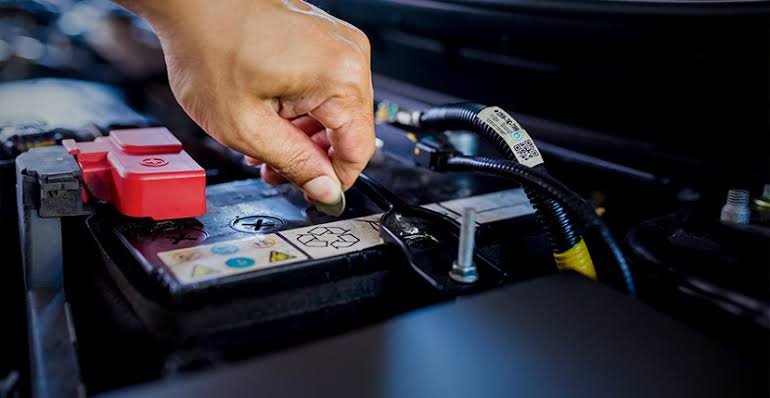Here's a sobering reality: According to NHTSA data, battery related injuries are the largest category of non crash motor vehicle incidents, with battery explosions leading the charge.
Yet walk into any parking lot and you'll hear someone say "I know my car" while connecting terminals in whatever order feels convenient. That confidence can cost you more than pride.
The answer is deceptively simple: Always connect the positive terminal first when installing a battery. But the why behind this rule, and the catastrophic consequences of ignoring it, reveals a deeper understanding that separates automotive professionals from weekend warriors.
The Science Behind the Sequence
When you connect a battery terminal, you're completing an electrical circuit. Think of your car's frame as one massive ground wire, because that's exactly what it is. The negative terminal connects directly to this frame, creating what engineers call a “chassis ground.”
Here's where it gets dangerous. If you connect the negative terminal first, your wrench becomes a potential conductor between the positive terminal and any grounded metal surface. One slip, one accidental contact, and you've created a direct short circuit capable of producing hundreds of amperes of current.
"The battery won't shock me," drivers often claim, dismissing the 12-volt system as harmless. They're technically correct about electrocution, but dangerously wrong about everything else. That short circuit generates intense heat, welding metal tools together and creating sparks hot enough to ignite hydrogen gas that naturally escapes from lead-acid batteries BateriHub.
The Professional's Protocol
Connect the positive terminal first, and you eliminate this risk entirely. With the negative terminal still disconnected, there's no complete circuit to the ground. Your tools can touch metal surfaces without consequence. The electrical pathway simply doesn't exist yet.
This isn't theoretical safety theater, it's based on real world failure analysis. As one veteran technician puts it: “I've seen guys weld wrenches to battery terminals. The wrench gets so hot you can't touch it for ten minutes.”
The sequence matters during removal too, but in reverse: negative terminal comes off first. This immediately breaks the ground connection, making subsequent work on the positive terminal safe. It's elegant in its simplicity, last on, first off.
Modern Electronics Change Everything
Today's vehicles aren't your grandfather's mechanical marvels. They're rolling computers with dozens of electronic control units (ECUs) that manage everything from fuel injection to airbag deployment. These sensitive components cost thousands to replace and can be damaged by voltage spikes caused by improper battery connection.
A short circuit doesn't discriminate. It can fry engine management systems, destroy infotainment units, or damage safety critical components like ABS controllers. The repair bills often exceed the vehicle's value.
Professional shops follow strict protocols for this reason. They use memory savers to maintain power to sensitive electronics during battery replacement, and they never ever deviate from positive-first connection procedures.
The Hidden Cost of Sparks
Those dramatic sparks might look impressive, but they're destroying your battery terminals with each occurrence. Electrical arcing creates pitting and corrosion that reduces connection quality over time. Poor connections create resistance, which generates heat, which accelerates battery failure.
Battery manufacturers design terminals for specific connection procedures. Deviation from these procedures can void warranties, a costly discovery when your premium battery fails prematurely.
The hydrogen gas issue isn't academic either. Batteries naturally produce hydrogen during normal operation, creating an explosive atmosphere around the terminals. Professional battery charging areas require special ventilation for this reason. Your garage or driveway doesn't have that protection.
Tools That Matter
Professional installation requires professional tools. A proper wrench set prevents the over-tightening that cracks terminal posts. Dielectric grease protects connections from corrosion. Battery terminal cleaners remove the oxide buildup that creates resistance.
"I'll tighten it until it feels right," is another dangerous assumption. Terminal manufacturers specify torque values for good reason. Over tightening cracks the lead posts. Under-tightening creates resistance and heat buildup.
Safety equipment isn't optional either. Eye protection guards against acid splashes. Gloves protect skin from both acid and sharp terminal edges. These aren't suggestions, they're requirements in professional shops because experience teaches hard lessons.
The Memory Factor
Modern vehicles store critical calibration data in volatile memory. Disconnecting the battery incorrectly can erase learned fuel trims, idle adjustments, and other adaptive parameters that took hundreds of miles to optimize.
Professional memory savers maintain this data during battery service, but they connect through the vehicle's electrical system, another reason proper grounding and connection procedures matter. A short circuit can damage the memory saver and the vehicle simultaneously.
Beyond Basic Safety
The positive first rule extends battery life through proper chemistry management. Lead acid batteries rely on controlled chemical reactions that can be disrupted by electrical surges. Even brief short circuits can damage internal plates and reduce capacity.
Temperature matters too. Batteries perform best when connections are clean, tight, and properly sequenced. Poor connections generate heat that accelerates electrolyte evaporation and plate sulfation, the leading causes of premature battery failure.
Professional installers check these factors systematically. They measure terminal voltage, test specific gravity, and verify proper charging system operation before declaring the job complete.
Battery connection sequence isn't arbitrary, it's engineering. Positive first, negative last during installation. Negative first, positive last during removal. This simple protocol prevents equipment damage, protects expensive electronics, and ensures reliable performance.
Your car might get you home with loose terminals and sloppy connections. But professional standards exist because professionals understand the difference between "working" and "working properly." The positive first rule embodies that difference.
In an industry where cutting corners can mean cutting lives short, this basic procedure remains non-negotiable. Master it, follow it religiously, and join the ranks of professionals who understand that proper technique isn't about showing off, it's about going home safely with everything still working.

Comments (0)
Please login to join the discussion
Be the first to comment on this article!
Share your thoughts and start the discussion